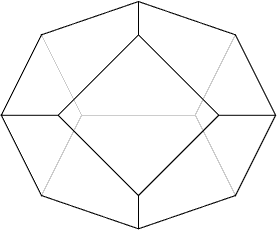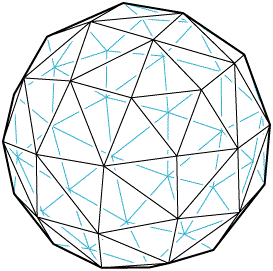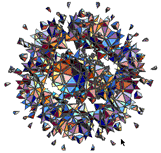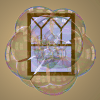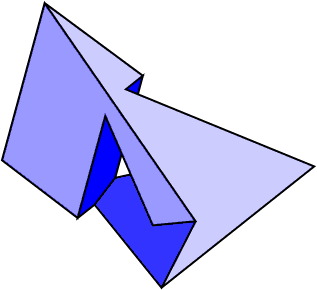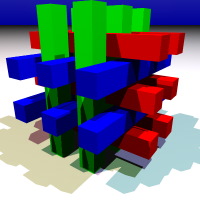
Polyhedra and Polytopes
This page includes pointers on geometric properties of polygons,
polyhedra, and higher dimensional polytopes (particularly convex
polytopes). Other pages of the junkyard collect related information
on triangles, tetrahedra, and simplices,
cubes and hypercubes,
polyhedral models,
and symmetry of regular polytopes.
- Adventures among the toroids. Reference to a book on polyhedral tori by B. M. Stewart.
- Archimedean solids:
John Conway describes some
interesting maps among the Archimedean
polytopes.
Eric Weisstein lists
properties
and pictures of the Archimedean solids.
- Associahedron
and Permutahedron.
The associahedron represents the set of triangulations of a hexagon,
with edges representing flips; the permutahedron represents the set of
permutations of four objects, with edges representing swaps.
This strangely asymmetric view of the associahedron (as an animated gif)
shows that it has some kind of geometric relation with the permutahedron:
it can be formed by cutting the permutahedron on two planes.
A more symmetric view is below.
See also a
more detailed description of the associahedron
and
Jean-Louis Loday's paper
on associahedron coordinates.
- David Bailey's
world of tesselations.
Primarily consists of Escher-like drawings but also includes
an interesting section about Kepler's work on polyhedra.
- Ned
Batchelder's Stellated Dodecahedron T-shirt.
- The bellows
conjecture, R. Connelly, I. Sabitov and A. Walz in Contributions to
Algebra and Geometry , volume 38 (1997), No.1, 1-10. Connelly had
previously discovered
non-convex polyhedra which are flexible (can move through a continuous
family of shapes without bending or otherwise deforming any faces);
these authors prove that in any such example, the volume remains
constant throughout the flexing motion.
- Bounded degree triangulation.
Pankaj Agarwal and Sandeep Sen ask for triangulations of convex polytopes
in which the vertex or edge degree is bounded by a constant or polylog.
- Buckyballs. The truncated icosahedron
recently acquired new fame and a new name when chemists discovered that
Carbon forms molecules with its shape.
- The charged particle
model: polytopes and optimal packing of p points in n dimensional spheres.
- Circumnavigating
a cube and a tetrahedron, Henry Bottomley.
- Cognitive Engineering
Lab, Java applets for exploring tilings, symmetry, polyhedra, and
four-dimensional polytopes.
- Complex
polytope. A diagram representing a complex polytope, from
H. S. M. Coxeter's home
page.
- a
computational approach to tilings. Daniel Huson investigates the
combinatorics of periodic tilings in two and three dimensions, including
a classification of the tilings by shapes topologically equivalent to
the five Platonic solids.
- Convex
Archimedean polychoremata, 4-dimensional analogues of the
semiregular solids, described by Coxeter-Dynkin diagrams
representing their symmetry groups.
- A Counterexample to Borsuk's Conjecture, J. Kahn and G. Kalai,
Bull. AMS 29 (1993). Partitioning certain high-dimensional polytopes
into pieces with smaller diameter requires a number of pieces
exponential in the dimension.
- Deltahedra, polyhedra with equilateral triangle faces. From Eric Weisstein's treasure trove of mathematics.
- Dodecafoam.
A fractal froth of polyhedra fills space.
- Dodecahedron
measures, Paul Kunkel.
- Domegalomaniahedron.
Clive Tooth makes polyhedra out of his
deep and inscrutable singular name.
- Explore the 120-cell!
Free Windows+OpenGL+.Net software.
- All the fair dice.
Pictures of the polyhedra which can be used as dice,
in that there is a symmetry taking any face to any other face.
- Chris Fearnley's 5 and 25 Frequency Geodesic Spheres rendered by POV-Ray.
- Five
Platonic solids and a soccerball.
- Five
space-filling polyhedra. And not the ones you're likely thinking of,
either.
Guy Inchbald, reproduced from Math. Gazette 80, November 1996.
- Flexible polyhedra. From Dave Rusin's known math pages.
- The Fourth
Dimension. John Savard provides a nice graphical explanation of the
four-dimensional regular polytopes.
- Four-dimensional visualization.
Doug Zare gives some pointers on high-dimensional visualization
including a description of an interesting chain of successively higher
dimensional polytopes beginning with a triangular prism.
- Geodesic
math. Apparently this means links to pages about polyhedra.
- Geometria
Java-based software for constructing and measuring polyhedra
by transforming and slicing predefined starting blocks.
- Geometry,
algebra, and the analysis of polygons. Notes by M. Brundage on a
talk by B. Grünbaum on vector spaces formed by planar
n-gons under componentwise addition.
- Geometry and the Imagination in Minneapolis.
Notes from a workshop led by Conway, Doyle, Gilman, and Thurston.
Includes several sections on polyhedra, knots, and symmetry groups.
- Glowing green rhombic triacontahedra in space.
Rendered by Rob Wieringa for the May-June 1997 Internet Ray Tracing Competition.
- The golden
section and Euclid's construction of the dodecahedron, and
more
on the dodecahedron and icosahedron,
H. Serras, Ghent.
- Polyhedra -
homage to U. A. Graziotti.
- Great
triambic icosidodecahedron quilt,
made by Mark Newbold and Sarah Mylchreest with the aid of
Mark's hyperspace star polytope slicer.
- Melinda
Green's geometry page. Green makes models of regular sponges
(infinite non-convex generalizations of Platonic solids) out of plastic
"Polydron" pieces.
- Hebesphenomegacorona
onna stick in space! Space Station Science picture of
the day. In case you don't remember what a hebesphenomegacorona is, it's
one of the Johnson solids: convex polyhedra with regular-polygon faces.
- Hecatohedra.
John Conway discusses the possible symmetry groups of hundred-sided polyhedra.
- Hilbert's
3rd Problem and Dehn Invariants.
How to tell whether two polyhedra can be dissected into each other.
See also Walter
Neumann's paper connecting these ideas with problems of
classifying manifolds.
- Holyhedra.
Jade Vinson solves a question of John Conway on the existence of
finite polyhedra all of whose faces have holes in them
(the Menger sponge provides
an infinite example).
- HypArr,
software for modeling and visualizing convex polyhedra and plane
arrangements,
now seems to be incorporated as a module in a larger
Matlab library for multi-parametric analysis.
- Hypergami polyhedral playground.
Rotatable wireframe models of platonic solids and of the penguinhedron.
- Hyperspace star
polytope slicer, Java animation by Mark Newbold.
- The icosahedron, the great icosahedron, graph designs, and Hadamard matrices. Notes by M. Brundage from a talk by M. Rosenfeld.
- Icosamonohedra,
icosahedra made from congruent but not necessarily equilateral triangles.
- Ideal
hyperbolic polyhedra
ray-traced by Matthias Weber.
- Guy Inchbald's
polyhedra pages.
Stellations, hendecahedra, duality, space-fillers, quasicrystals, and more.
- The International
Bone-Roller's Guild ponders the
isohedra:
polyhedra that can act as fair dice, because all faces are symmetric to
each other.
- Investigating
Patterns: Symmetry and Tessellations.
Companion site to a middle school text by Jill Britton,
with links to many other web sites involving symmetry or tiling.
- Jenn
open-source software for visualizing Cayley graphs of Coxeter groups
as symmetric 4-dimensional polytopes.
- Johnson Solids, convex polyhedra with regular faces. From Eric Weisstein's
treasure trove of mathematics.
- Sándor Kabai's
mathematical graphics, primarily polyhedra and 3d fractals.
- Kepler-Poinsot
Solids, concave polyhedra with star-shaped faces. From Eric
Weisstein's treasure trove of mathematics. See also
H. Serras'
page on Kepler-Poinsot solids.
- Links2go: Polyhedra
- Louis Bel's povray galleries:
les
polyhèdres réguliers,
knots,
and
more knots.
- Lunatic's
guide to polyhedra.
- 3-Manifolds from regular solids.
Brent Everitt lists the finite volume orientable hyperbolic and
spherical 3-manifolds obtained by identifying the faces of regular solids.
- Maple
polyhedron gallery.
- Martin's pretty
polyhedra. Simulation of particles repelling each other on the
sphere produces nice triangulations of its surface.
- Mathematica Graphics Gallery: Polyhedra
- Max.
non-adjacent vertices on 120-cell. Sci.math discussion on the size
of the maximum independent set on this regular 4-polytope.
Apparently
it is known to be between 220 and 224 inclusive.
- Minesweeper
on Archimedean polyhedra, Robert Webb.
- Models of Platonic solids
and related symmetric polyhedra.
- Netlib polyhedra.
Coordinates for regular and Archimedean polyhedra,
prisms, anti-prisms, and more.
- Nine.
Drew Olbrich discovers the associahedron by evenly spacing nine points
on a sphere and dualizing.
- Nonorthogonal polyhedra built from rectangles.
Melody Donoso and Joe O'Rourke answer an open question of Biedl, Lubiw,
and Sun.
- Occult correspondences of the Platonic solids.
Some random thoughts from
Anders
Sandberg.
- Pappus
on the Archimedean solids. Translation of an excerpt of a fourth century
geometry text.
- Peek, software for visualizing high-dimensional polytopes.
- Penumbral shadows of polygons
form projections of four-dimensional polytopes.
From the Graphics Center's graphics archives.
- Pictures of 3d and 4d regular solids, R. Koch, U. Oregon.
Koch also provides some
4D regular solid visualization applets.
- The
Platonic solids. With Java viewers for interactive manipulation. Peter Alfeld, Utah.
- Platonic
solids and Euler's formula. Vishal Lama shows how the formula can be
used to show that the familiar five Platonic solids are the only ones
possible.
- Platonic
solids and quaternion groups, J. Baez.
- Platonic
solids transformed by Michael Hansmeyer using subdivision-surface
algorithms into shapes
resembling radiolarans.
See also Boing Boing discussion.
- Platonic spheres.
Java animation, with a discussion of platonic solid classification,
Euler's formula, and sphere symmetries.
- Platonic Universe,
Stephan Werbeck. What shapes can you form by gluing regular dodecahedra
face-to-face?
- Poly, Windows/Mac shareware
for exploring various classes of polyhedra including Platonic solids,
Archimedean solids, Johnson solids, etc. Includes perspective views,
Shlegel diagrams, and unfolded nets.
- Polygonal and polyhedral geometry. Dave Rusin, Northern Illinois U.
- Polygons as projections of polytopes.
Andrew Kepert answers a question of
George Baloglou on whether every planar figure formed by a convex
polygon and all its diagonals can be formed by projecting a
three-dimensional convex polyhedron.
- Polygons,
polyhedra, polytopes, R. Towle.
- Polyhedra.
Bruce Fast is building a library of images of polyhedra.
He describes some of the regular and semi-regular polyhedra,
and lists names of many more including the Johnson solids
(all convex polyhedra with regular faces).
- Polyhedra
collection, V. Bulatov.
- Polyhedra
exhibition.
Many regular-polyhedron compounds, rendered in povray by Alexandre Buchmann.
- Polyhedra
pastimes, links to teaching activities collected by J. Britton.
- A
polyhedral analysis. Ken Gourlay looks at the Platonic solids and
their stellations.
- Polyhedron,
polyhedra, polytopes, ... - Numericana.
- Polyhedron challenge: cuboctahedron.
- Polyhedron web scavenger hunt
- PolyGloss.
Wendy Krieger is unsatisfied with terminology for higher dimensional geometry
and attempts a better replacement.
Her geometry works
include some other material on higher dimensional polytopes.
- Polytope
movie page. GIF animations by Komei Fukuda.
- Proofs of Euler's Formula.
V-E+F=2, where V, E, and F are respectively the numbers of
vertices, edges, and faces of a convex polyhedron.
- Puzzles
by Eric Harshbarger, mostly involving colors of and mazes on
polyhedra and polyominoes.
- Puzzles
with polyhedra and numbers,
J. Rezende.
Some questions about labeling edges of platonic solids with numbers,
and their connections with group theory.
- The
Puzzling World of Polyhedral Dissections.
Stewart T. Coffin's classic book on geometric puzzles,
now available in full text on the internet!
- Quark constructions.
The sun4v.qc Team investigates polyhedra that fit together
to form a modular set of building blocks.
- A quasi-polynomial bound for the diameter of graphs of polyhedra,
G. Kalai and D. Kleitman, Bull. AMS 26 (1992). A famous open conjecture in polyhedral
combinatorics (with applications to e.g. the simplex method in linear
programming) states that any two vertices of an n-face polytope are
linked by a chain of O(n) edges. This paper gives the weaker bound
O(nlog d).
- Realization Spaces of 4-polytopes are Universal,
G. Ziegler and J. Richter-Gebert, Bull. AMS 32 (1995).
- Regular
polyhedra as intersecting cylinders.
Jim Buddenhagen exhibits ray-traces of the shapes formed by
extending half-infinite cylinders around rays from the center
to each vertex of a regular polyhedron.
The boundary faces of the resulting unions form
combinatorially equivalent complexes to those of the dual polyhedra.
- Regular
polytopes in higher dimensions. Russell Towle uses Mathematica to
slice and dice simplices, hypercubes, and the other high-dimensional
regular polytopes.
See also
Russell's 4D star
polytope quicktime animations.
- Regular polytopes in Hilbert space.
Dan Asimov asks what the right definition of such a thing should be.
- Regular solids.
Information on Schlafli symbols, coordinates, and duals
of the five Platonic solids.
(This page's title says also Archimedean solids, but I don't see many of
them here.)
- Resistance and
conductance of polyhedra. Derek Locke computes formulae for networks
of unit resistors in the patterns of the edges of the Platonic solids.
See also the section on resistors in the rec.puzzles faq.
- Rhombic
spirallohedra, concave rhombus-faced polyhedra that tile space,
R. Towle.
- Rolling
polyhedra. Dave Boll investigates Hamiltonian paths on (duals of)
regular polyhedra.
- Ruler and Compass.
Mathematical web site including special sections on the
geometry of
polyhedrons and
geometry
of polytopes.
- The
Simplex: Minimal Higher Dimensional Structures.
D. Anderson.
- Simplex/hyperplane intersection.
Doug Zare nicely summarizes the shapes that can arise on intersecting
a simplex with a hyperplane: if there are p points on the hyperplane,
m on one side, and n on the other side, the shape is
(a projective transformation of)
a p-iterated cone over the product of m-1 and n-1 dimensional simplices.
- Six-regular toroid.
Mike Paterson asks whether it is possible to make a torus-shaped polyhedron
in which exactly six equilateral triangles meet at each vertex.
- SMAPO
library of polytopes encoding the solutions to optimization problems
such as the TSP.
- Soap bubble 120-cell
from the Geometry Center archives.
- Solution
of Conway-Radin-Sadun problem.
Dissections of combinations of regular dodecahedra, regular icosahedra,
and related polyhedra into rhombs that tile space. By Dehn's solution to
Hilbert's third problem this is impossible for individual dodecahedra
and icosahedra, but Conway,
Radin, and Sadun showed that certain combinations could work.
Now Izidor Hafner shows how.
- Squares
are not diamonds. Izzycat gives a nice explanation of why
these shapes should be thought of differently, even though they're
congruent: they generalize to different things in higher dimensions.
- Stella and Stella4d,
Windows software for visualizing regular and semi-regular polyhedra and
their stellations in three and four dimensions, morphing them into each other, drawing unfolded nets for
making paper models, and exporting polyhedra to various 3d design packages.
- Stellations
of the dodecahedron stereoscopically animated in Java by Mark Newbold.
- Sterescopic polyhedra
rendered with POVray by Mark Newbold.
- The
Story of the 120-cell, John Stillwell, Notices of the AMS. History,
algebra, geometry, topology, and computer graphics of this
regular 4-dimensional polytope.
- Structors.
Panagiotis Karagiorgis thinks he can get people to pay large sums of
money for exclusive rights to use four-dimensional regular polytopes
as building floor plans. But he does have some pretty pictures...
- Student of
Hyperspace. Pictures of 6 regular polytopes, E. Swab.
- Superliminal
Geometry. Topics include deltahedra, infinite polyhedra, and flexible
polyhedra.
- Symmetries of torus-shaped polyhedra
- Symmetry,
tilings, and polyhedra, S. Dutch.
- Synergetic
geometry, Richard Hawkins' digital archive. Animations and 3d
models of polyhedra and tensegrity structures. Very
bandwidth-intensive.
- The Szilassi Polyhedron.
This polyhedral torus, discovered by
L.
Szilassi, has seven hexagonal faces, all adjacent to each other.
It has an axis of 180-degree symmetry; three pairs of faces are congruent
leaving one unpaired hexagon that is itself symmetric.
Tom
Ace has more images as well as a downloadable unfolded pattern
for making your own copy.
See also Dave Rusin's page on
polyhedral
tori with few vertices and
Ivars'
Peterson's MathTrek article.
- Tales of the
dodecahedron, from Pythagoras to Plato to Poincaré. John
Baez, Reese Prosser Memorial Lecture, Dartmouth, 2006.
- 3D-Geometrie.
T. E. Dorozinski provides a gallery of images of 3d polyhedra,
2d and 3d tilings, and subdivisions of curved surfaces.
- Three dimensional turtle talk description of a dodecahedron. The dodecahedron's description is "M40T72R5M40X63.435T288X296.565R5M40T72M40X63.435T288X296.565R4"; isn't that helpful?
- Three untetrahedralizable objects
- Triangles and squares.
Slides from a talk I gave relating a simple 2d puzzle, Escher's drawings
of 3d polyhedra, and the combinatorics of 4d polytopes, via angles in
hyperbolic space. Warning: very large file (~8Mb).
For more technical details see
my
paper with Kuperberg and Ziegler.
- Truncated
Octahedra. Hop David has a nice picture of Coxeter's regular sponge
{6,4|4}, formed by leaving out the square faces from a tiling of space by truncated octahedra.
- Truncated
Trickery: Truncatering.
Some truncation relations among the Platonic solids and their friends.
- Tuvel's
Polyhedra Page and
Tuvel's Hyperdimensional
Page.
Information and images on universal polyhedra and higher dimensional polytopes.
- Two-distance sets.
Timothy Murphy and others discuss how many points one can have
in an n-dimensional set, so that there are only two distinct
interpoint distances. The correct answer turns out to
be n2/2 + O(n).
This
talk abstract by Petr Lisonek (and paper in JCTA 77 (1997) 318-338)
describe some related results.
- Uniform
polychora.
A somewhat generalized definition of 4d polytopes,
investigated and classified by J. Bowers, the polyhedron dude.
See also the dude's pages on
4d polytwisters
and
3d
uniform polyhedron nomenclature.
- Uniform polyhedra.
Computed by Roman Maeder using a Mathematica
implementation of a method of Zvi Har'El.
Maeder also includes separately a picture of the
20 convex uniform polyhedra, and descriptions of the
59
stellations of the icosahedra.
- Uniform
polyhedra in POV-ray format, by Russell Towle.
- Uniform
polyhedra, R. Morris. Rotatable 3d java view of these polyhedra.
- An uninscribable 4-regular polyhedron.
This shape can not be drawn with all its vertices on a single sphere.
- Variations of Uniform Polyhedra, Vince Matsko.
- Visual
techniques for computing polyhedral volumes.
T. V. Raman and M. S. Krishnamoorthy use Zome-based ideas
to derive simple expressions for the volumes of the Platonic solids
and related shapes.
- Visualization of the Carrillo-Lipman Polytope. Geometry arising from the simultaneous comparison of multiple DNA or protein sequences.
- Volumes in
synergetics. Volumes of various regular and semi-regular polyhedra,
scaled according to inscribed tetrahedra.
- Volumes of ideal hyperbolic hypercubes.
- Volumes of pieces of a dodecahedron.
David Epstein (not me!) wonders why parallel slices through the layers
of vertices of a dodecahedron produce equal-volume chunks.
- Waterman polyhedra,
formed from the convex hulls of centers of points near the origin in an
alternating lattice.
See also Paul
Bourke's Waterman Polyhedron page.
- Why doesn't Pick's theorem generalize?
One can compute the volume of a two-dimensional polygon with integer
coordinates by counting the number of integer points in it and on its
boundary, but this doesn't work in higher dimensions.
- Why "snub cube"?
John Conway provides a lesson on polyhedron nomenclature and etymology.
From the geometry.research archives.
- Zonohedra and zonotopes. These centrally
symmetric polyhedra provide another way of understanding the
combinatorics of line arrangements.
From the Geometry Junkyard,
computational
and recreational geometry pointers.
Send email if you
know of an appropriate page not listed here.
David Eppstein,
Theory Group,
ICS,
UC Irvine.
Semi-automatically
filtered
from a common source file.
